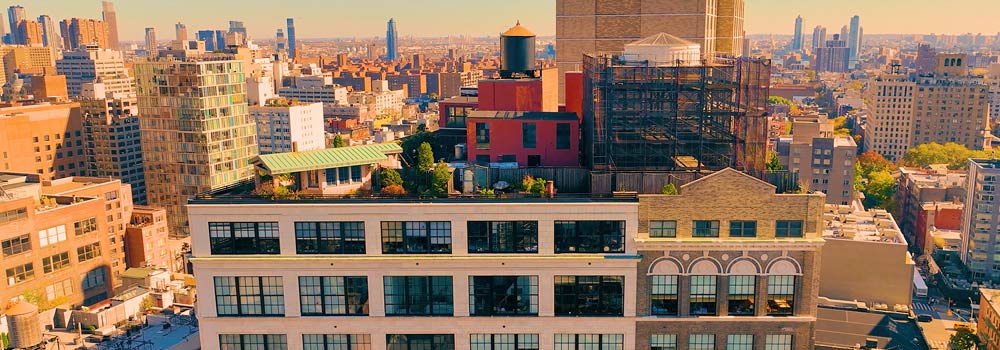International Tailoring Co. Building
Manhattan County

A case study for future-proofing a multifamily building with clean energy solutions.
Multifamily Incentives
FlexTech: Cost-share support for site-specific studies on how to implement clean energy and efficiency technologies.
Low Carbon Pathways: Flexible incentives for energy-saving retrofit projects.
The residents living in the co-op apartments located in the International Tailoring Company Building faced the same challenge many others living in older New York City buildings experience daily: frequent discomfort stemming from an older system that relied on a seasonal switchover, providing either heating or cooling.
“I knew we had a system nearing end-of-life, and personally, I was uncomfortable in my apartment for chunks of the year,” says co-op board president Eric Einstein. “I wasn’t happy, and I wanted to make sure we were doing something that would make it more pleasant to live in the building.”
The desire was to modernize the co-op building’s heating and cooling system with one that would allow residents the choice of being able to either heat or cool their unit. Einstein says the board was focused on installing heat pumps.
Building Summary
- 173-unit, 13-story co-op building, mostly one-bedroom and studio apartments
- Built in 1921
- Formerly a clothing manufacturing facility
- Converted to residential units in 1980

“We started talking about heat pumps maybe 18 months ago. People are excited to have heat or cold when they want. The building staff is excited to have equipment that’s not constantly breaking.”
– Eric Einstein
The co-op participated in NYSERDA’s Low-Carbon Pathways program and enlisted Ecosystem Energy to lead the improvement project.
Ecosystem devised a solution that repurposed the building’s existing hydronic loop system rather than starting from scratch, which would have cost significantly more according to Einstein.
The upgrades include 192 hybrid fan coil units, 9 central air-to-water heat pumps, two new condensing boilers, smart thermostats in each apartment unit, and a web-based building management system with centralized control of all heating and cooling components. A new adiabatic dry cooler took the place of the old cooling tower.
Built-In Efficiencies Save Energy Year-round
Throughout each season, the system will take advantage of several efficiencies to reduce the building’s energy needs. In the summer, waste heat will be used to heat domestic hot water. In the winter, heat pumps will pull heat from the outdoor air to provide the building’s heating needs. On the coldest days, the condensing boilers will supplement the heat pumps at efficiencies near 96.5%. In shoulder seasons, waste heat from sun-soaked apartments using air conditioning will provide heating to shaded apartments, all without the use of the central plant equipment.
Projected energy usage savings:
38%
from the modernized thermal network alone
+ additional savings from the BMS & smart thermostats
“Inherently, it’s going to save energy,” says Ecosystem’s Senior Project Development Engineer Ben Milbank. “Three times less energy for the same heat, a significant drop in the building’s energy use intensity.” Milbank notes that the building management system will handle most of the complexity involved with heating and cooling the building efficiently, while individual unit owners will be able to take advantage of the features of the smart thermostats to dial in their comfort while saving energy, such as occupancy sensors and temperature recommendations.
Preparing for a Low-Carbon Future
“The whole energy efficiency and Local Law 97 stuff was kind of a happy accident,” says Einstein. “This is the right technology for us, no matter what, even without any of the climate laws. It turned out to be the right place, right time, and coincidence.”
On top of getting a comfortable, energy efficient heating and cooling solution, the building also gets a solution that is low carbon.
Milbank estimates the upgrades will reduce the building’s carbon emissions by about 80%, putting the co-op at less risk of receiving fines for non-compliance with New York City’s Local Law 97.
“I knew the City was in the process of passing some laws that would affect our building,” says board member Erica Hanson, who noted it was wise of them to “take advantage of having a little bit of lead time to figure out how to borrow enough money and meet the right partners to make a big project happen.”
Significant Upfront and Long-Term Financial Savings
“This building is now compliant through 2050, and we were able to scoop up all this incentive money at the same time, which is just wonderful,” says Einstein, referring to the NYS Clean Heat and Low-Carbon Pathway incentives they were able to take advantage of which covered 22% of total project costs. Additionally, the electrification measures alone are projected to reduce the overall energy use by 38% per year.
Construction is already underway and is estimated to be completed in Summer 2023.
Interested in low-carbon building upgrades?
Visit NYSERDA's Low-Carbon Pathways program page or contact us at [email protected].
- Energy use intensity (EUI) is a metric used to describe a building’s energy use as a function of its size or other characteristics. EUI can be expressed as energy per square foot per year. (ENERGYSTAR.gov)
- New York City Local Law 97 establishes greenhouse gas emissions caps for buildings over 25,000 sq. ft. that are subject to benchmarking. Exceeding the emission cap could result in financial penalties. More information about planning for Local Law 97 compliance can be found here.

